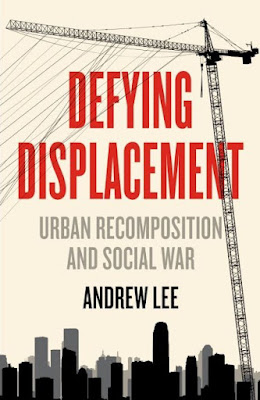Image: the cover of the book is an off white background with a black and gray silhouetted city skyline across the bottom. A crane extends up along the right side and across the top. Below that in large red letters is "defying displacement." Below that in gray letters is "urban recomposition and social war." Below that in black letters is "Andrew Lee."
Defying Displacement is one of the best texts I've read regarding gentrification and related struggles. Don't let the length fool you though. Andrew Lee uses it quite well and packs a ton of well researched info into a short space. I wish more books were focused like this one is on quality of information rather than filling space. The book is not simply an academic exercise though, which brings me to more of its strengths.
While there is a little jargon here and there, DD is overall accessibly written. Much can be said about texts written about target populations and struggles in a language that only those with expensive educations tend to speak and/or can easily grasp. More than the accessibility aspect though, there is real style to this book. It is artfully constructed in both how it's written and how it's organized. The book has a sort of narrative arc in a way despite being full of short chapters that sometimes jump from place to place. Lee has a way with words that drew me into the struggles he was discussing. He uses more quotes from people experiencing and resisting gentrification than he does quotes from outside "experts" on the issue. He focuses on those who may not have the academic language for what they're doing, but who have real experience in the struggle in ways that are even more valuable than those who joined based on the category of resistance. I imagine that any reader would have a tough time making an argument against his points.
Much of the text discusses issues around gentrification that are common in every text on the topic- (usually) white people and business owners move into a low income neighborhood (often) of color and systematically displace those people by raising housing costs and attracting their friends and colleagues who then paint the original inhabitants as a problem. Lee delves deeper into how exactly these things occur and how tech industries especially have come to play a major part. He also discusses how these industries often still require labor from the displaced people, not only making their rent skyrocket, but requiring them to still find a way to commute back to work in the area for the gentrifiers.
Lee also goes over the many ways that initiatives that may seem good to an outsider are used as vehicles of gentrification. Things like "eco friendly transit" can be used as a trojan horse for gentrification. The proponents may even claim that it will help current residents before promptly finding ways to force them out. Another effort would be to bring "the arts" or other developments to the area, ignoring and often removing the art and culture already existing there.
Lee also has criticisms and suggestions for various leftist movements. He discusses the real issues with flattening the "working class" into a homogenous group. He also discusses the problems with trying to apply the exact politics of leftist movements from decades ago onto the world of today. We must be more creative in how we approach problems, especially with how ingrained the tech industries are that were not present in the days of Lenin or Goldman.
There are many more discussions woven throughout the text which reads to me like a simultaneous human interest story, academic essay, and grounded manifesto. I really enjoyed Lee's artful way of telling a story using what can often be dense or confusing bits of info. If someone wanted a book on gentrification, either a beginner or someone with experience, I'd feel comfortable handing them this. As a side note, AK Press' printing has great graphic design, making reading all the more engaging and enjoyable.
This was also posted to my storygraph and goodreads.

No comments:
Post a Comment